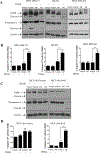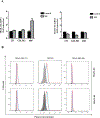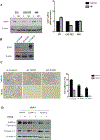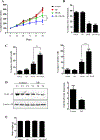Metformin sensitizes triple-negative breast cancer to proapoptotic TRAIL receptor agonists by suppressing XIAP expression
- PMID: 28324269
- PMCID: PMC6544153
- DOI: 10.1007/s10549-017-4201-0
Metformin sensitizes triple-negative breast cancer to proapoptotic TRAIL receptor agonists by suppressing XIAP expression
Abstract
Purpose: Despite robust antitumor activity in diverse preclinical models, TNF-related apoptosis-inducing ligand (TRAIL) receptor agonists have not demonstrated efficacy in clinical trials, underscoring the need to identify agents that enhance their activity. We postulated that the metabolic stress induced by the diabetes drug metformin would sensitize breast cancer cells to TRAIL receptor agonists.
Methods: Human triple (estrogen receptor, progesterone receptor, and HER2)-negative breast cancer (TNBC) cell lines were treated with TRAIL receptor agonists (monoclonal antibodies or TRAIL peptide), metformin, or the combination. The effects on cell survival, caspase activation, and expression of TRAIL receptors and the antiapoptotic protein XIAP were determined. In addition, XIAP was silenced by RNAi in TNBC cells and the effects on sensitivity to TRAIL were determined. The antitumor effects of metformin, TRAIL, or the combination were evaluated in an orthotopic model of metastatic TNBC.
Results: Metformin sensitized diverse TNBC cells to TRAIL receptor agonists. Metformin selectively enhanced the sensitivity of transformed breast epithelial cells to TRAIL receptor agonist-induced caspase activation and apoptosis with little effect on untransformed breast epithelial cells. These effects of metformin were accompanied by robust reductions in the protein levels of XIAP, a negative regulator of TRAIL-induced apoptosis. Silencing XIAP in TNBC cells mimicked the TRAIL-sensitizing effects of metformin. Metformin also enhanced the antitumor effects of TRAIL in a metastatic murine TNBC model.
Conclusions: Our findings indicate that metformin enhances the activity of TRAIL receptor agonists, thereby supporting the rationale for additional translational studies combining these agents.
Keywords: Apoptosis; Breast cancer; Metastasis; Metformin; TRAIL; Therapeutics.
Conflict of interest statement
Figures






Similar articles
-
Methionine Deprivation Induces a Targetable Vulnerability in Triple-Negative Breast Cancer Cells by Enhancing TRAIL Receptor-2 Expression.Clin Cancer Res. 2015 Jun 15;21(12):2780-91. doi: 10.1158/1078-0432.CCR-14-2792. Epub 2015 Feb 27. Clin Cancer Res. 2015. PMID: 25724522 Free PMC article.
-
ONC201 Demonstrates Antitumor Effects in Both Triple-Negative and Non-Triple-Negative Breast Cancers through TRAIL-Dependent and TRAIL-Independent Mechanisms.Mol Cancer Ther. 2017 Jul;16(7):1290-1298. doi: 10.1158/1535-7163.MCT-17-0121. Epub 2017 Apr 19. Mol Cancer Ther. 2017. PMID: 28424227 Free PMC article.
-
Aspirin sensitizes cancer cells to TRAIL-induced apoptosis by reducing survivin levels.Clin Cancer Res. 2008 May 15;14(10):3168-76. doi: 10.1158/1078-0432.CCR-07-4362. Clin Cancer Res. 2008. PMID: 18483385
-
The role of XIAP in resistance to TNF-related apoptosis-inducing ligand (TRAIL) in Leukemia.Biomed Pharmacother. 2018 Nov;107:1010-1019. doi: 10.1016/j.biopha.2018.08.065. Epub 2018 Aug 24. Biomed Pharmacother. 2018. PMID: 30257312 Review.
-
Targeting TRAIL Death Receptors in Triple-Negative Breast Cancers: Challenges and Strategies for Cancer Therapy.Cells. 2022 Nov 22;11(23):3717. doi: 10.3390/cells11233717. Cells. 2022. PMID: 36496977 Free PMC article. Review.
Cited by
-
Importance of TRAIL Molecular Anatomy in Receptor Oligomerization and Signaling. Implications for Cancer Therapy.Cancers (Basel). 2019 Mar 29;11(4):444. doi: 10.3390/cancers11040444. Cancers (Basel). 2019. PMID: 30934872 Free PMC article. Review.
-
Metformin as an adjuvant in breast cancer treatment.SAGE Open Med. 2019 Jul 16;7:2050312119865114. doi: 10.1177/2050312119865114. eCollection 2019. SAGE Open Med. 2019. PMID: 31360518 Free PMC article. Review.
-
Methionine restriction activates the integrated stress response in triple-negative breast cancer cells by a GCN2- and PERK-independent mechanism.Am J Cancer Res. 2019 Aug 1;9(8):1766-1775. eCollection 2019. Am J Cancer Res. 2019. PMID: 31497357 Free PMC article.
-
PYK2 promotes HER2-positive breast cancer invasion.J Exp Clin Cancer Res. 2019 May 22;38(1):210. doi: 10.1186/s13046-019-1221-0. J Exp Clin Cancer Res. 2019. PMID: 31118051 Free PMC article.
-
Upregulation of endogenous TRAIL-elicited apoptosis is essential for metformin-mediated antitumor activity against TNBC and NSCLC.Mol Ther Oncolytics. 2021 Apr 29;21:303-314. doi: 10.1016/j.omto.2021.04.012. eCollection 2021 Jun 25. Mol Ther Oncolytics. 2021. PMID: 34141868 Free PMC article.
References
-
- Plummer R, Attard G, Pacey S, Li L, Razak A, Perrett R, Barrett M, Judson I, Kaye S, Fox NL et al. (2007) Phase 1 and pharmacokinetic study of lexatumumab in patients with advanced cancers. Clin Cancer Res 13(20):6187–94 - PubMed
-
- Soria JC, Smit E, Khayat D, Besse B, Yang X, Hsu CP, Reese D, Wiezorek J, Blackhall F (2010) Phase 1b study of dulanermin (recombinant human Apo2L/TRAIL) in combination with paclitaxel, carboplatin, and bevacizumab in patients with advanced non-squamous non-small-cell lung cancer. J Clin Oncol 28(9):1527–33 - PubMed
-
- Herbst RS, Eckhardt SG, Kurzrock R, Ebbinghaus S, O’Dwyer PJ, Gordon MS, Novotny W, Goldwasser MA, Tohnya TM, Lum BL et al. (2010) Phase I dose-escalation study of recombinant human Apo2L/TRAIL, a dual proapoptotic receptor agonist, in patients with advanced cancer. J Clin Oncol 28(17):2839–46 - PubMed
MeSH terms
Substances
Grants and funding
LinkOut - more resources
Full Text Sources
Other Literature Sources
Research Materials
Miscellaneous

